It’s 2025 and personalization is no longer just a trend—it’s what customers expect.
Personalization makes marketing more effective, whether it’s a Netflix recommendation that keeps you hooked or an email that feels like it was written just for you.
But just how powerful is it? The numbers tell a compelling story.
From higher conversion rates to stronger customer loyalty, businesses that use the power of personalization see real results.
In this article, we’ll dive into the latest personalization statistics that prove why personalization matters and how brands can use it to create better experiences.
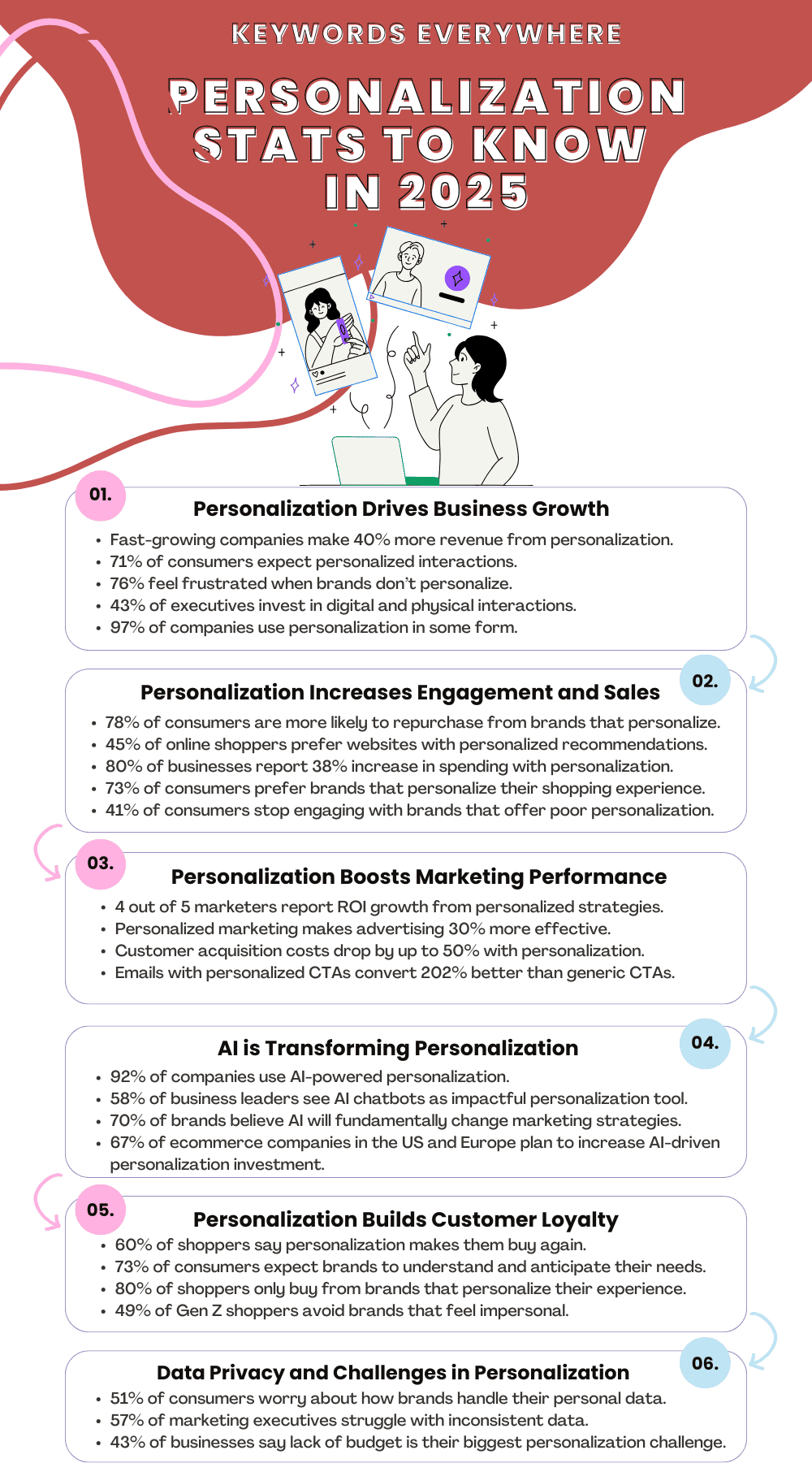
Top Personalization Stats
Personalization is the process of using data to tailor brand messages, products, and experiences to individual customers based on their demographics, interests and buying behavior.
Top brands are already using personalization to drive engagement and revenue. For example, Netflix, Amazon, and YouTube suggest content to users based on their behavior to keep them hooked.
Here are top personalization stats to show how important it is in today’s competitive era:
1. Personalization drives business growth. Fast-growing companies make 40% more of their revenue from personalization than those growing more slowly.
2. Research from McKinsey shows that 71% of consumers expect businesses to provide personalized interactions, and 76% get frustrated when they don’t receive them. With so many choices available, switching to a competitor has never been easier.
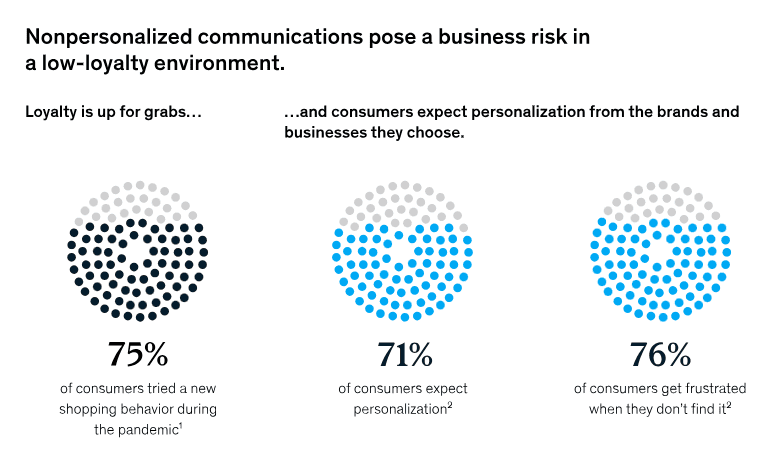
Nonpersonal communications pose a risk to business
3. 76% of consumers say personalized communication makes them more likely to consider a brand, and 78% say it increases the likelihood of them making repeat purchases.
4. According to Think With Google, 9 in 10 marketers believe that using personalization significantly contributes to business profitability.
5. A survey of B2C marketers and consumers found that 14% of companies personalize experiences sometimes, 50% do so often, and 34% always make personalization a priority. In total, 97% of companies use personalization in some form, while only 1% never personalize experiences and 2% rarely do.
6. Over 70% of brands believe that AI will fundamentally transform personalization and marketing strategies.
7. 61% of companies worry that inaccurate data could negatively impact their AI-driven personalization efforts, reinforcing the idea that poor-quality data leads to poor results.

Inaccurate data negatively impacts AI-driven personalization efforts
8. A study by EverString and Ascend2 found that 69% of companies consider personalizing the customer experience a top priority. In comparison, 41% focus on acquiring new customers, and 36% prioritize targeting specific market segments.
9. About 45% of online shoppers are more likely to purchase from websites that offer personalized recommendations, and 40% tend to buy more from retailers that personalize the shopping experience across multiple channels.
10. According to Keywords Everywhere, the term “personalized advertisement” gets searched 90,500 times per month, proving that businesses are working hard to make personalize ads for better engagement and conversions.
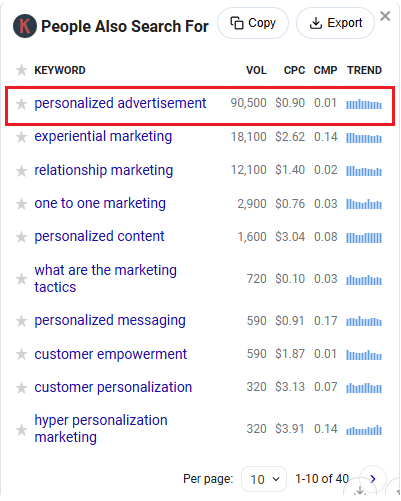
Personalization Investment and Market Growth Stats
Companies are investing heavily in personalized experiences to boost customer engagement, improve brand loyalty among users, and grow their revenue.
Here are some personalization stats that help you understand why companies invest in a personalization program.
11. The customer experience and personalization software industry is predicted to grow from $7.6 billion in 2021 to $11.6 billion by 2026, showing how fast businesses are investing in tailored customer experiences.

Customer experience and personalization software industry revenue (2020-2026)
12. 43% of businesses say their biggest challenge in delivering personalized experiences is a lack of budget and resources.
13. 67% of ecommerce businesses in the U.S. and Europe plan to increase their investment in personalization to enhance customer engagement and sales.
14. Companies are prioritizing personalization more than ever, with marketers now spending 40% of their budgets on it—almost double the 22% allocated in 2023.
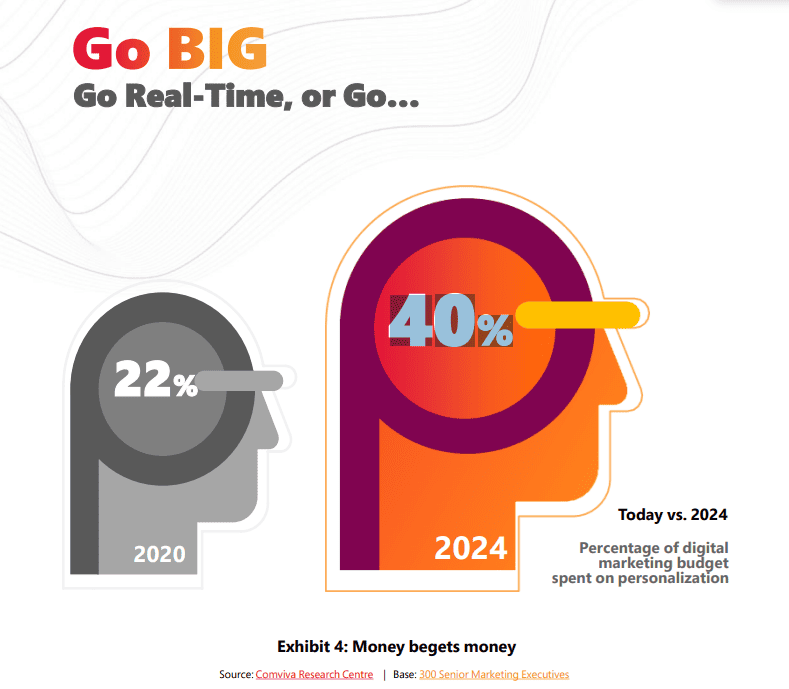
Percentage of digital marketing budget spent on personalization
15. 43% of executives invest in hybrid experiences, combining digital and physical interactions to create seamless, personalized customer journeys.
16. Personalization delivers strong returns—4 out of 5 marketers report growth in ROI after implementing personalized strategies. In fact, 89% say it helps them connect with customers across multiple touchpoints and drive better results.
Personalization and Customer Loyalty Stats
Personalization is important for building strong relationships with customers, and top brands are using it to drive loyalty and repeat business.
Starbucks, for example, has mastered this through its Loyalty Program by using machine learning to give personalized offers at scale based on customer preferences.
Shoppers now expect businesses to understand their needs and provide tailored experiences. Here’s what the numbers say:
17. 49% of Gen Z shoppers are less likely to buy from a brand if the experience feels impersonal, and 27% will stop shopping entirely or share negative feedback.
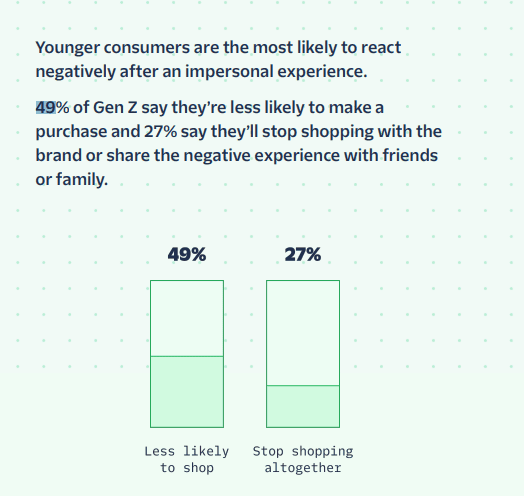
Customer reaction to negative shopping experience
18. 60% of shoppers say a personalized experience makes them more likely to become repeat customers.
19. 36% of customers will stay loyal to a brand after a great experience, even if there are cheaper or more convenient options.
20. 73% prefer brands that use their personal information to make shopping experiences more relevant.
21. 70% say a company’s ability to understand their needs directly influences their loyalty.
22. 62% of consumers lose loyalty when brands fail to offer personalized interactions.
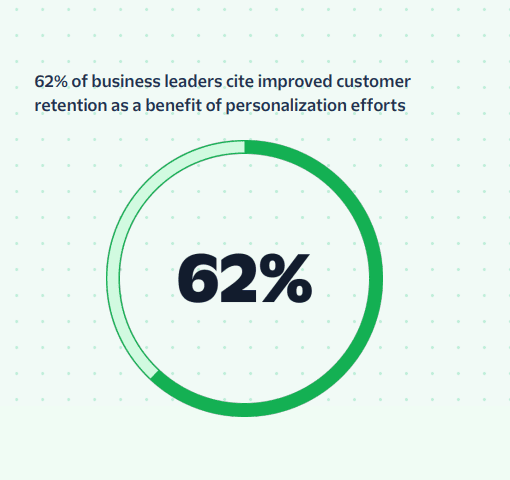
Customer retention is a benefit of personalization
23. 80% of frequent shoppers only buy from brands that personalize their experience.
24. Millennial loyalty increases by 28% when brands communicate with them in a personalized way.
Personalization ROI and Conversion Stats
Investing in personalization directly impacts a company’s bottom line.
From increasing revenue and customer spending to lowering acquisition costs, all businesses that prioritize personalized experiences see measurable financial gains.
Here are some personalization stats that reveal how it affects revenue and conversion rates:
25. 89% of U.S. marketers say personalizing mobile app experiences leads to higher revenue.
26. 80% of businesses report that when they personalize customer experiences, spending increases by an average of 38%.
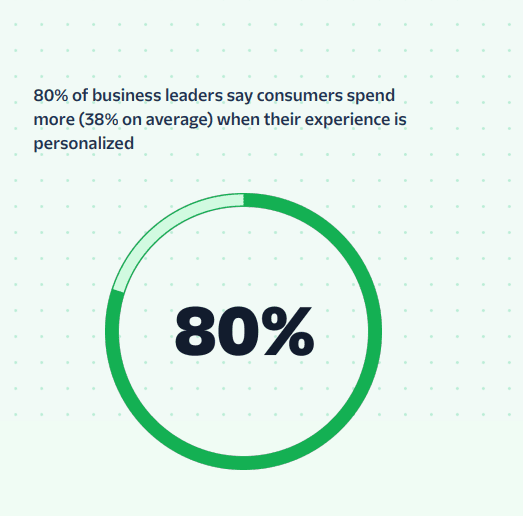
Personalization leads to increase in consumer spending
27. 52% of consumers feel more satisfied when brands offer personalized interactions.
28. Personalization not only boosts engagement but also improves efficiency—marketing spend becomes 30% more effective, and customer acquisition costs drop by up to 50%.
29. Banks can see massive gains—for every $100 billion in assets, a bank could generate $300 million more in revenue by personalizing customer interactions.
30. By 2024, personalization will influence over 30% of all revenue, nearly doubling from 16% today, marking an 88% increase across industries.

Revenue impact of personalization has increased over last few years
31. Fintech companies and digital banks are leading the way in real-time personalization, aiming to boost revenue by 43% in 2024. Other industries are following suit, including digital banks (38%), retail and eCommerce (30%), communication service providers (19%), and traditional banks (18%).
Email Personalization Stats
Personalized email marketing is another powerful tool for boosting engagement and sales. Here’s what the email personalization stats say:
32. Personalized emails see a 29% open rate and an impressive 41% click-through rate, making them far more effective than generic messages.
33. 49% of consumers prefer receiving promotional emails from their favorite retail brands every week.
34. According to data from Keywords Everywhere, the search volume for all keywords related to “personalized emails” is high, indicating that businesses are actively looking for ways to engage customers through tailored messages.
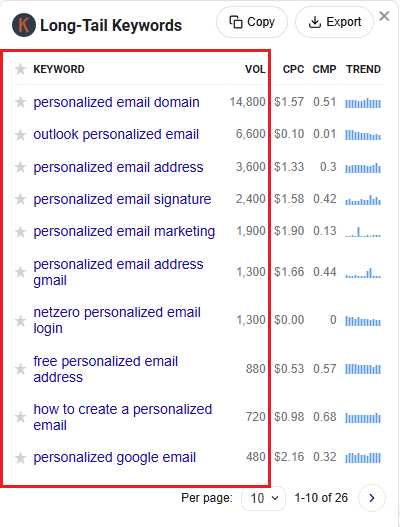
35. 55% of consumers say their email experience would improve if they received more targeted promotions and personalized discounts.
36. 57% of marketers believe that email personalization is a key driver of visitor engagement.
37. A staggering 96% of marketers agree that personalized emails enhance overall marketing performance, making it one of the most effective personalization strategies.
38. Emails with customized calls to action (CTAs) perform exceptionally well, generating a 202% higher conversion rate compared to generic CTAs.
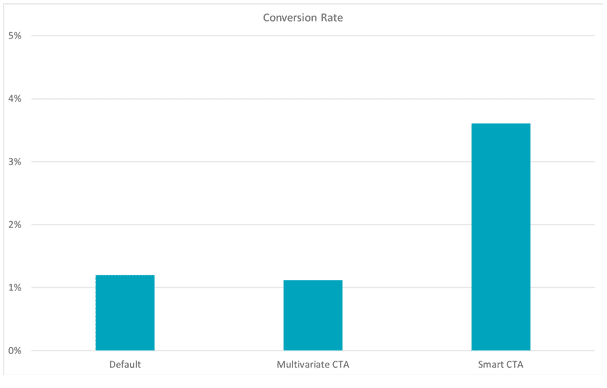
Personalized CTAs convert better than basic CTAs
Ecommerce Personalization Stats
The global eCommerce market has grown rapidly in recent years. In 2023, retail eCommerce sales surpassed $5.8 trillion, according to Statista.
With more customers shopping online and increasing competition among businesses, personalizing the customer experience is now more important than ever.
Here are some important eCommerce personalization stats to keep an eye on:
39. 73% of shoppers expect companies to know and learn their unique needs, while 62% expect them to anticipate their needs.
40. 28% of shoppers consider a personalized experience an important factor when choosing between retailers.
41. 63% of consumers stop engaging with brands that offer poor personalization.
42. 88% of consumers say a company’s experience matters as much as its products or services.

Attitude of consumers toward personalization provided by a company
43. 41% of retail executives say that their eCommerce platform is somewhat personalized, while only 13% claim it provides a fully tailored experience.
44. More than 27% of retailers have integrated generative AI into their customer loyalty programs, and 13% plan to adopt it next year.
45. 70% of retailers that invested in personalization reported an ROI of at least 400%.
46. 96% of retailers face challenges in personalization, including limited IT capacity, finding the right platform or partner, and internal alignment issues.
47. More than 40% of U.S. eCommerce executives cite IT bandwidth as a major obstacle to implementing personalized shopping experiences.
Personalization and Data Privacy Stats
Personalization comes with lots of responsibilities, especially when it comes to protecting the data of your customers. As companies gather information to deliver personal experiences, they must also ensure that the data is handled with care.
So, let’s explore some eye-opening personalization statistics that shed light on this delicate challenge.
48. 53% of business leaders are upgrading their technology to better manage customer data in response to privacy changes.
49. 57% of senior marketing executives struggle with data inconsistencies, making it harder to deliver personalized experiences.
50. Only 51% of consumers trust brands to keep their personal data safe and also to use it responsibly.
51. Concerns about data use are growing—1 in 4 consumers feel less comfortable sharing their personal information for personalization than they did last year.
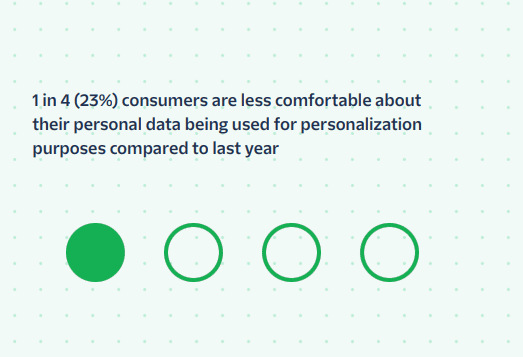
Consumers are increasingly aware of how their data is being used
52. Latin American businesses are leading the way in data privacy, with 71% of business leaders investing in stronger security measures to protect customer data.
53. 78% of businesses see first-party data—such as purchase history and website behavior—as the most valuable source for personalization, offering deeper insights into customer needs.
54. With stricter privacy regulations, 27% of consumers feel that personalization has become less accurate over the past year.
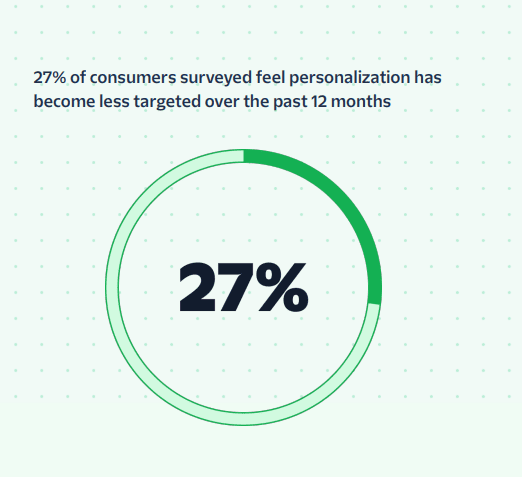
Consumers have noticed less targeted personalization in the past year
AI Personalization Stats
AI-driven personalization is transforming the way most businesses engage with customers, but adoption comes with its own set of challenges. Here’s what the latest data reveals:
55. 92% of companies are already using some kind of AI-powered personalization to drive business growth.
56. Despite 84% of marketing executives believing in AI’s potential for personalization, only 17% use it extensively today.
57. 58% of business leaders see AI chatbots as the most impactful personalization tool for the next five years.
58. The road to AI adoption isn’t without hurdles—business leaders cite lack of training, security concerns, compliance issues, poor organizational processes, and data quality as the biggest challenges.
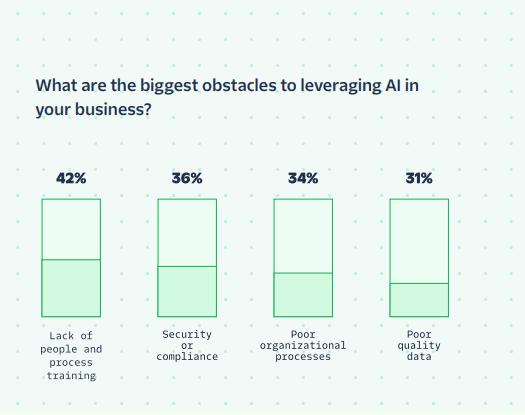
Top obstacles in using AI for personalization
59. 41% of consumers are somewhat comfortable with AI personalizing their experiences, while the rest remain skeptical—perhaps influenced by too many sci-fi movies.
60. Concerns about AI-driven personalization are relatively low, with only 24% of customers expressing unease.
Conclusion
Personalization isn’t just a nice touch—it’s what customers expect from brands now. Businesses that personalize experiences see more sales, better customer loyalty, and stronger engagement.
When done right, personalization makes marketing more effective and helps brands connect with their audience. But when done poorly, it can push customers away and hurt a brand’s reputation.
As the personalization stats show, it’s shaping the future of business. Companies that invest in it will stay ahead, build stronger customer relationships, and keep people coming back.


